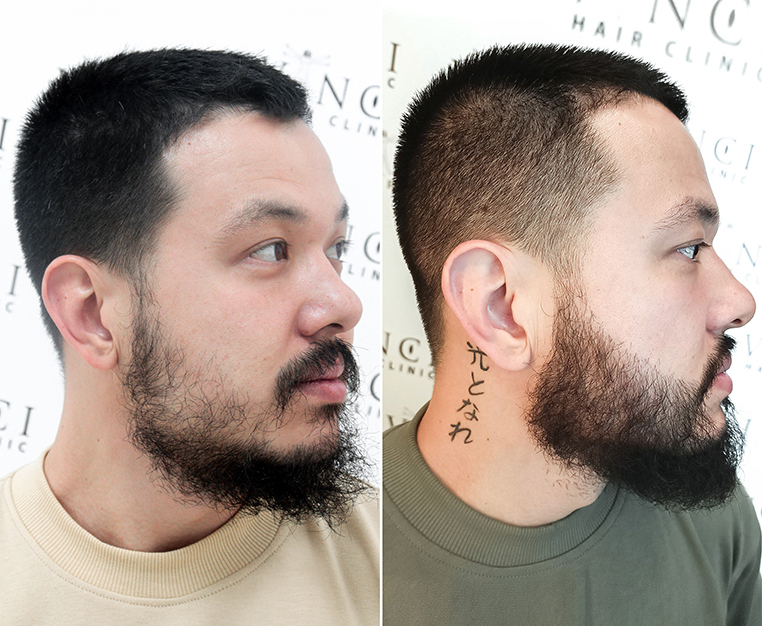Short answer: Yes, hair transplants do work. And yes, you should consider one, especially if you are experiencing thinning hair.
Hair loss can be a source of significant concern for many individuals, impacting not only their physical appearance but also their self-esteem and confidence. As technology in the field of cosmetic procedures advances, one option gaining popularity is hair transplantation.
Simply known as hair transplants, these surgical procedures involve the extraction of hair follicles from one part of the body (usually the back or sides of the scalp) and transplanting them to an area experiencing hair loss.
The two most common types of hair transplants are known as Follicular Unit Transplantation (FUT) and Follicular Unit Extraction (FUE).
This article aims to explore the effectiveness and permanence of hair transplants, helping individuals make informed decisions about whether this procedure is the right choice for them.
What Are Hair Transplants and How Do They Work?
Hair transplants are surgical procedures designed to address hair loss and restore hair growth in areas where it has thinned or receded. These procedures involve the extraction of hair follicles from one part of the body, typically referred to as the “donor area,” and their transplantation to another area, known as the “recipient area” or the area experiencing hair loss.
There are two main types of hair transplant procedures:
Follicular Unit Transplantation (FUT):
Also known as the strip method, FUT involves the removal of a narrow strip of scalp from the donor area. The strip is then dissected into individual follicular units, each containing one to four hairs. These units are meticulously transplanted into the recipient area, recreating a natural hairline.
Follicular Unit Extraction (FUE):
FUE is a minimally invasive technique that involves the extraction of individual hair follicles directly from the donor area using a specialised punch tool. These individual follicular units are then transplanted into the recipient area.
Both FUT and FUE have their advantages and considerations, and the choice between them often depends on factors such as the patient’s preferences, the extent of hair loss, and the surgeon’s expertise.
The success of a hair transplant largely relies on the following factors:
- Donor Area Selection: The donor area is critical as it provides the hair follicles that will be transplanted. Typically, the back and sides of the scalp are chosen because the hair follicles in these areas are genetically resistant to the hormones that cause hair loss.
- Graft Preparation: The extracted hair follicles are carefully dissected into individual grafts. Each graft contains hair follicles, as well as associated structures to ensure their survival and growth.
- Recipient Site Creation: The surgeon creates tiny incisions in the recipient area, determining the angle, direction, and density of hair growth. This step is crucial for achieving a natural-looking result.
- Graft Implantation: The individual grafts are delicately placed into the recipient site, ensuring proper alignment and orientation.
Are They Effective at Stopping Hair Loss and Promoting Hair Growth?
Numerous studies and clinical trials have demonstrated the effectiveness of hair transplants in restoring natural-looking hair for individuals experiencing pattern baldness or hair thinning.
The success of the procedure often depends on various factors, including the patient’s overall health, the skill of the surgeon, and the type of hair transplant technique used.
Permanence of Hair Transplants
One of the key questions individuals contemplating a hair transplant often ask is whether the results are permanent. The good news is that hair transplants can provide long-lasting results.
The transplanted hair follicles are typically resistant to the hormonal changes that cause pattern baldness, making them a permanent addition to the recipient area.
It’s important to note that while the transplanted hair is permanent, the procedure does not prevent further hair loss in non-transplanted areas. Therefore, individuals considering a hair transplant should have realistic expectations and understand that additional sessions may be required in the future to address ongoing hair loss.
Should You Consider a Hair Transplant?
Yes, you should consider a hair transplant especially if you’re experiencing the trauma of hair loss. Hair transplant has proven to be an effective and permanent solution for many individuals dealing with hair loss.
Consulting with a qualified professional is crucial to obtaining accurate information and guidance tailored to one’s unique circumstances.
Tired of Thinning Hair? Discover Lasting Solutions with Vinci Hair Clinic
Are you constantly grappling with the frustration of thinning hair and receding hairlines? The journey of hair loss can be disheartening, impacting not just your appearance but also your confidence.
At Vinci Hair Clinic, we understand the struggles you face, and we’re here to offer a personalised solution that goes beyond conventional approaches.
Why Vinci? With decades of collective experience, our team of skilled surgeons brings a wealth of knowledge to every procedure. Over the years, we have refined our techniques, staying at the forefront of advancements in hair transplant technology.
Visit our website to explore how Vinci Hair Clinic can help you embark on a wholistic hair recovery journey.


